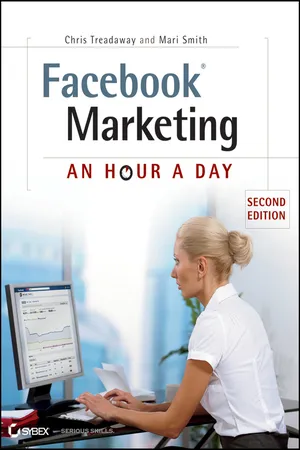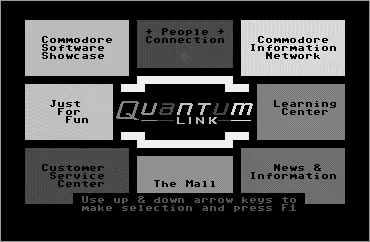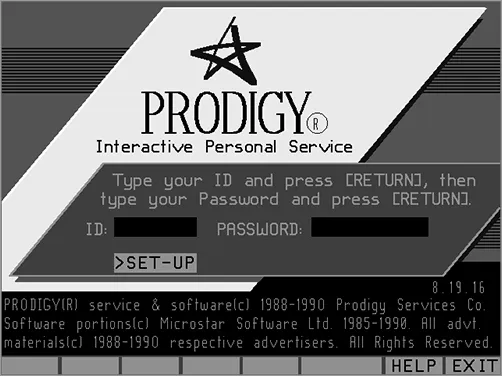![]()
Chapter 1
Welcome to the Post-Social Era
In just a few short years, we’ve gone from being relative neophytes in social media to having a vast majority of our personal connections and brand affinities captured in Facebook. Facebook is now the dominant player in social media. No other company comes close to Facebook’s market penetration and the rich set of data it has been able to collect. However, the initial wonderment of social media is now gone. People have discovered long-lost friends, have met new people, and have interacted in ways that were unimaginable before Facebook. What was once cool is now mainstream. What does that mean for Facebook users and the marketers who are so desperate to reach a mass audience?
Chapter Contents
- The Humble Beginnings of Social Marketing
- The Emergence of Social Networks
- The Social Media Revolution Takes Over
- Novelty Gone in the Post-Social Era
The Humble Beginnings of Social Marketing
We all enjoy life through a series of defining experiences with friends and loved ones in our social circles: people who attend the same school, live on the same street, work in the same company, or root for the same team. The jeans they wear, the phones they use, and the brands they favor to some extent encourage us to think positively or negatively about ourselves and others. They’re consumers just like us, and they shape our thoughts and opinions in profound ways that we rarely notice.
All of us have been pitched products in advertising from memorable spokespeople: Spuds McKenzie, Joe Isuzu, the lonely Maytag repair guy, Max Headroom, the Geico gecko, and the California Raisins, to name just a few. We remember catchy sayings like “Every Kiss Begins with K(ay),” “Where’s the Beef?,” “Just Do It,” and “Calgon, Take Me Away!” We respond to their honesty, their humor, and their brute force, and we take on their marketing messages by making subtle, subconscious changes to how we live, what we consume, and what we think.
For years, experiences were lived largely “offline.” Our interactions have been in person, in front of a television, or through headphones. But times are different. Internet technologies and social media have enhanced our online experiences. We enjoy interactivity, video, audio, and pictures just as much from computer screens as from offline experiences. We want to learn, share, and interact from the comfort of our computers and mobile devices more than ever.
For me (Chris), it started when my parents bought a Commodore 64 in 1984 along with a 300 baud modem. Connecting to other users in the “online world” was a novel concept at the time—it was 1984, after all! But I wanted to experience the future firsthand. My first taste of social computing was on a service called Quantum Link (see Figure 1-1). Quantum Link was one of the very first online services that combined electronic mail, public file sharing, and games. It was fascinating. To play games, I didn’t need to get permission from my parents to invite people over. I could do it from the comfort of my own bedroom and at any time of the day or night. The only problem was the pesky usage fees. Mom and Dad didn’t seem too excited about a big bill for “plus” services. Nonetheless, I got my first taste of social computing on Quantum Link.
Online Services v1
Three major competitors—Prodigy, CompuServe, and America Online (AOL)—evolved over the following years. All three took online services to an entirely different level with improved user interfaces made possible by advances in computer hardware and operating systems. Some of the first real-time online services were made available via Prodigy (a joint venture between CBS, IBM, and Sears) in the early 1990s—news, sports scores, weather, and so on. Prodigy also offered premium content from the Mobil Travel Guide and Zagat’s Restaurant Ratings, to name a few. But perhaps most important, Prodigy had a very well-integrated message board and email services that allowed people to meet, discover similar interests, and communicate with one another. These were the “killer apps” behind the growth of the Internet in the early 1990s. They were, in effect, the first generation of modern social networks. Figure 1-2 shows the Prodigy login screen, which may be familiar to early pioneers of the Internet era.
While Prodigy, CompuServe, and AOL were pioneers in the online services business, they were not particularly interesting channels for e-commerce or Internet marketing. Most notable was Prodigy’s classified ad experiment with USA Today, whereby Prodigy offered advertisers the opportunity to reach parts of the Prodigy user base for as little as $60/month for an approximately 250-character text advertisement. Prodigy also made screen space available to advertisers through teasers, or what would be viewed today as banner advertising, at the bottom of each screen. If a consumer was interested in the advertisement, they could click the advertisement to get more information via a larger version of the ad and then buy the product or service being offered. But neither advertising option became sufficiently popular and effective for Prodigy or any other online service. Internet advertising was only a $55 million industry worldwide in 1995; it was just too early for people to respond well to the advertising of goods and services on the Internet. Compare that to the $25.7 billion Internet marketing business in 2009. Because Internet advertising was so ineffective early on, Prodigy, CompuServe, and AOL focused primarily on growing consumer subscription revenue by increasing subscribers in the mid-1990s.
Emergence of the World Wide Web
The proliferation of proprietary first-generation online services came to a stunning halt with the emergence of Mosaic, the first widely available web browser. In 1994, with Mosaic and a web connection via an Internet service provider (ISP), a user could spend an unlimited amount of time surfing the Internet and sending an unlimited number of email messages. This was a departure from existing services that relied upon tiered hourly service rates and other usage upcharges for profitability. Fueled by the wealth of new online services, applications, and a proliferation of websites, consumers moved to the World Wide Web en masse starting in 1995.
As users flocked to the Internet, the first experiments in Internet marketing were already underway. Hotwired, an online web magazine, was the first company to sell banner advertising to corporations, in late 1994. Figure 1-3 shows the first banner ad ever sold, an AT&T advertisement. Banner ads were long, rectangular advertisements, usually 468 pixels wide by 60 pixels tall, with information and/or graphics designed to entice a reader into clicking them to visit another website. They were sold for a flat rate per 1,000 impressions or views, which is now referred to as cost per mil (CPM). Around the same time, a number of experiments popped up to guarantee clicks and not just impressions. The idea was that advertisers wanted visitors and not just views.
The mid-1990s were revolutionary for the Internet, as millions of people got online. The possibilities were endless, as were questions about how advertising could be used to build new businesses, new opportunities, and new communities. How would people interact with each other? How much would the Internet change purchase behavior? How would business be conducted differently in the age of the Internet? What new business opportunities would be possible? All of the possibilities led to an unprecedented level of entrepreneurial activity from both new companies and established corporations. Everyone wanted an opportunity to participate and reap the spoils.
As a result, the Internet advertising business grew tremendously through banner advertising. Sites could devote a certain amount of space to banners to generate revenue. It was a good deal for advertisers as well because, at the time, it was the best way to reach people and get them to learn about another site on the Internet or a product, service, or other offer. For no less than five years, banner advertising was the best Internet marketing opportunity available to people who wanted to connect with consumers on the Web. This dynamic led the developers of many early popular websites to turn their sites into portals, that is, sites that would help users get a wide range of information that would be helpful in a personal and sometimes professional context. By building an effective portal, a company could create a thriving and growing web property that would generate revenue and profits through banner advertising.
Search and the Decline of Banner Ads
The number of websites continued to proliferate well beyond people’s expectations. Consumers needed a way to sort through all the noise to find exactly what they needed at any given time. A number of companies built sites to help with this exact problem. Publishers eager to cash in on the craze even created books that offered all the links to the Web you could possibly want—in print, of all things! Yahoo! indexed sites by subject matter and added a rudimentary search function that helped users find resources quickly. Other sites didn’t rely on a proprietary directory but instead depended on scanning the full text of web pages to determine the relevance of a particular search term. Popular search engines from this period included Magellan, Excite, Inktomi, AltaVista, and Lycos. Later, other search engines, such as MetaCrawler and Dogpile, emerged, combining search results from individual search engines to provide more accurate and complete results to users. Over time, these search engines became the “starting point” for many users. Rather than logging into a portal like Go.com or MSN to get information, users began to frequent search engines.
Before long, it became apparent that users preferred an effective, powerful search engine to all other means of finding relevant information on the Internet. Enter Google. I (Chris) remember the first time I used Google in early 1999. I was stunned by how it so easily and quickly pointed me to the exact information I needed at the time and, more important, how consistently effective the search engine was regardless of the search term I used. It took just a few tries for me to realize that Google was revolutionary. Like a lot of other Internet users, I ditched every other search engine I had used before and converted to Google. Contrary to popular belief, Google did not immediately revolutionize Internet advertising. It was primarily a great search engine for several years while the company experimented with a variety of business models.
The world continued to buy and sell banner advertising as the primary means for generating demand on the Internet, although banner advertising certainly peaked in the late 1990s for a few reasons. For one, the proliferation of websites meant that the number of advertising options increased significantly. More options = lower prices. Negotiating power shifted from the publisher to the advertiser, who now had more available options for ad spending. Second, the novelty of Internet advertising wore off to some extent. Click-through rates on banners dropped from as high as 2% to well below 0.5%, and with that drop came a reduction in prices. No longer were companies blindly sinking thousands of dollars into banner advertising. Advertisers demanded results, which increasingly worked against banner advertising. Third, consumers experienced some level of banner ad fatigue. These ads were everywhere on the Internet by 1999, which also made them somewhat easy to ignore. This created an environment ripe for the emergence of a new, effective, and trackable way to reach consumers.
The Rise of Google and Click-Throug...



